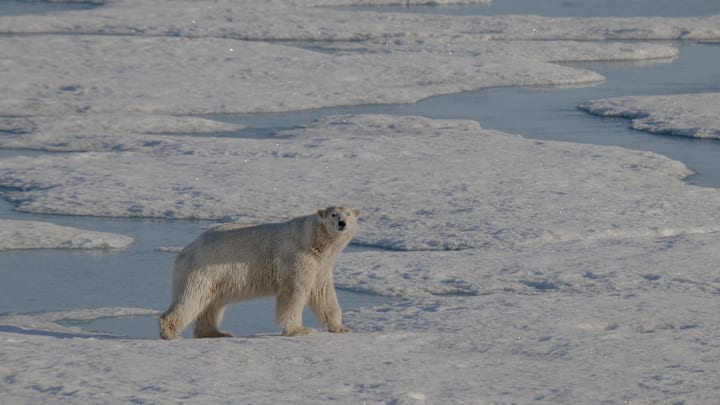Polar bears survive by hunting on sea ice, which makes them especially vulnerable to climate change. New research shows that sea ice loss can present other, less obvious threats to the species as well. According to a recent study published in the journal PLOS ONE, polar bears are exposed to more potentially harmful pathogens today compared to 30 years ago.
A team of U.S.-based researchers came to this conclusion after analyzing blood and feces samples from 232 polar bears collected between 2008 and 2017. After testing the materials for antibodies, or blood proteins generated by the immune system to fight foreign substances, the scientists compared the results to 115 historical polar bear samples collected from 1987 to 1994.
They found a significant presence of five pathogens—Francisella tularensis, Neospora caninum, Toxoplasma gondii, Brucella abortus/suis, and canine distemper virus—in both of the sample groups. The pathogen that saw the smallest uptick was also the most prevalent overall: canine distemper virus was present in 55.3 percent of bears in the historical cohort compared to 69.8 percent in the new sample, an increase of 26.2 percent. In contrast, the least prevalent pathogen saw the biggest bump. Just 2.2 percent of bears in the older cohort were infected with T. gondii, but that percentage jumped to 14.1 in the second sample, an increase of nearly 541 percent.
Smithsonian reports that bacterial or viral prevalence varied based on the bears’ sex. The findings showed that female bears exhibited more cases of specific pathogens commonly found on land, likely due to their tendency to care for their cubs in dens.
Increased exposure to certain pathogens can be traced back to the bears’ diets, which include seals as well as birds, eggs, seaweed, and carrion. This implies that polar bears aren’t the only Arctic species facing these threats—seals, walruses, and whales are likely contracting them in greater numbers as well.
The question of whether the pathogens are causing harm to polar bears remains to be seen. The study’s lead author Dr. Karyn Rode told BBC, “Bears in general are pretty robust to disease. It’s not typically been known to affect bear population, but I think what it just highlights is that things [in the Arctic] are changing.” Indeed, research has shown the Arctic is warming up four times faster than the rest of the world.
While these pathogens alone may not be enough to wipe out polar bears, they represent stressors that the bears could do without.
Read More About Animals:
